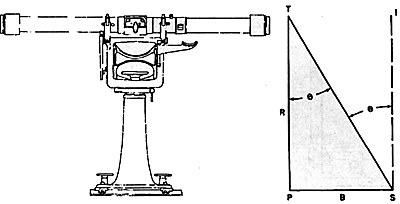The development of the optical range finder came about as gunnery technology achieved longer and longer ranges. At short ranges, a rough estimate of target range was sufficient because flat shell fire had a large danger space; a measure of the area where a shell will impact the target. At long ranges, however, the danger space decreases considerably and thus a precise determination of range becomes a necessity for accurate gun fire.
Optical range finders estimate a target's range by solving a right triangle in which one side and two angles are known. Referring to the diagram below, the length of the range finder (B) is the base of the triangle and the angle -TPS is set by the definition of a right triangle to 90'. The instrument then only has to solve for the angle of convergence, -IST, in order to determine the range to the target (R). There are two basic methods whereby an operator will know when the range finder has correctly measured the angle of convergence. The first is the stereoscopic range finder which uses the stereoacuity or binocular vision of the operator.
The second method is the coincidence range finder which uses monocular vision, or vision through one eye. A stereoscopic range finder can determine range quicker than a coincidence range finder, but it doesn't hold a target's range well from one sighting to the next and thus can be more labor intensive. Stereoscopic range finders can also lose calibration faster than coincidence range finders. Finally, stereoscopic range finder operators require a thorough screening, as binocular vision varies drastically from one person to the next.
Below:
- Barr & Stroud FQ2 9 ft Coincidence Range Finder
Ranging Triangle (right)

Gunnery Standards in the Admiralty Trilogy Games
Armor Piercing Cap
Optical Range Finder
BT
Back to The Naval Sitrep #12 Table of Contents
Back to Naval Sitrep List of Issues
Back to MagWeb Master Magazine List
© Copyright 1997 by Larry Bond and Clash of Arms.
This article appears in MagWeb (Magazine Web) on the Internet World Wide Web.
Other military history articles and gaming articles are available at http://www.magweb.com